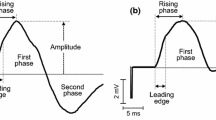Abstract
A modified line source model presented earlier has been used to study the decline of the extracellular single muscle fibre action potential. The muscle tissue is modelled as a low-pass filter. The transfer function of the filter declines more slowly than a first order low-pass filter at low frequencies, but much faster at high frequencies. The cutoff frequency of the filter increases when the anisotropy of the muscle decreases. It also increases proportionally with the propagation velocity of the action potential. The decline of different frequency components obtained from the modified line source volume conductor and a filter model derived from experimental measurements are compared and their differences explained. The modified line source model was found to be identical to the volume conductor model in terms of results and at the same time conceptually simple for applications.
Similar content being viewed by others
References
Gath, I. andStålberg, E. (1977) On the volume conduction in human skeletal muscle:in situ measurements.Electroenceph. & Clin. Neurophysiol.,43, 106–110.
Gath, I. andStålberg, E. (1978) The calculated radial decline of the extracellular action potential compared within situ measurements in the human brachial biceps,,44, 547–552.
Geddes, L. A. andBaker, L. E. (1967) The specific resistance of biological material.Med. & Biol. Eng.,5, 271–293.
Gielen, F. (1983) Electrical conductivity and histological structure of skeletal muscle. Thesis at Department of Electrical Engineering, Twente University of Technology, Enschede, The Netherlands.
Nandedkar, S. D. andStålberg, E. (1983a) Simulation of single muscle fibre action potentials.Med. & Biol. Eng. & Comput.,21, 158–165.
Nandedkar, S. D. andStålberg, E. (1983b) Simulation of macro EMG motor unit potentials.EEG & Clin. Neurophysiol.,56, 52–62.
Rosenfalck, P. (1969) Intra- and extracellular potential fields of active nerve and muscle fibres. A physiomathematical analysis of different models.Acta Physiol. Scand., Suppl.,321, 1–168.
Stålberg, E. andGath, I. (1979) Measurement of the uptake area of small size electromyographic electrodes.IEEE Trans.,BME-26, 374–376.
Stålberg, E. andThiele, B. (1975) motor unit fibre density in the extensor digitorium communis muscle.J. Neurol. Neurosurg. Psychiatry,38, 874–880.
Author information
Authors and Affiliations
Rights and permissions
About this article
Cite this article
Nandedkar, S.D., Sigl, J.C., Kim, Y.I. et al. Radial decline of the extracellular action potential. Med. Biol. Eng. Comput. 22, 564–568 (1984). https://doi.org/10.1007/BF02443871
Received:
Accepted:
Issue Date:
DOI: https://doi.org/10.1007/BF02443871




